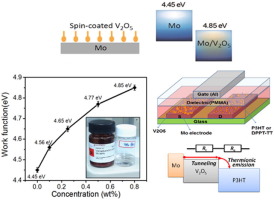Solution processed vanadium pentoxide as charge injection layer in polymer field-effect transistor with Mo electrodes
- 저자
- Dand Xuan Long, Yong Xu, Seok-Ju Kang, Won-Tae Park, Eun-Young Choi, Chuan Liu*, and Yong-Young Noh*
- 저널명
- Organic Electronics, 17, 66-76 (2015)
- 년도
- 2015
- Link
- http://dx.doi.org/10.1016/j.orgel.2014.11.020 406회 연결
[Abstract]
We report on high-performance organic field-effect transistors (OFETs) with low-cost Mo source/drain electrode by incorporating solution-processed V2O5 thin-film interlayers. The original V2O5 powder of orange color is dissolved in NH3 solvent (0.5 wt%) and changed into a transparent solution after moderate heating. We are able to fabricate V2O5 thin films (1–6 nm) on Mo electrodes by simple spin-coating. Kelvin probe measurements reveal that the work function of the Mo electrodes progressively changed from 4.4 to 4.9 eV. With the insertion of the V2O5 layer, OFETs gained significantly improved p-type performance for both regioregular poly(3-hexylthiophene) (rr-P3HT) and ambipolar 3,6-Bis-(5bromo-thiophen-2-yl)-N,N-bis(2-octyl-1-dodecyl)-1,4-dioxo-pyrrolo[3,4-c]pyrrole (DPPT-TT) polymer semiconductors. OFETs on the basis of rr-P3HT or DPPT-TT with V2O5/Mo electrodes exhibit field-effect mobilities of 0.15 and 1.91 cm2/V s, respectively, highly improved from 0.05 and 1.2 cm2/V s in case of OFETs with bare Mo. This performance is already comparable with that of OFETs employing much more expensive Au electrodes. After investigating the contact resistance, we propose that the improvement relies on balancing two factors: modulating the injection barrier by tuning the work function, and manipulating the tunnel distance by controlling the film thickness.
